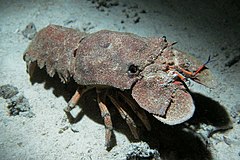| Scyllarides latus | |
|---|---|

| |
| Scientific classification | |
| Domain: | Eukaryota |
| Kingdom: | Animalia |
| Phylum: | Arthropoda |
| Class: | Malacostraca |
| Order: | Decapoda |
| Suborder: | Pleocyemata |
| Family: | Scyllaridae |
| Genus: | Scyllarides |
| Species: | S. latus
|
| Binomial name | |
| Scyllarides latus | |
| Synonyms | |
| |
Scyllarides latus, the Mediterranean slipper lobster, is a species of slipper lobster found in the Mediterranean Sea and in the eastern Atlantic Ocean. It is edible and highly regarded as food, but is now rare over much of its range due to overfishing. Adults may grow to 1 foot (30 cm) long, are camouflaged, and have no claws. They are nocturnal, emerging from caves and other shelters during the night to feed on molluscs. As well as being eaten by humans, S. latus is also preyed upon by a variety of bony fish. Its closest relative is S. herklotsii, which occurs off the Atlantic coast of West Africa; other species of Scyllarides occur in the western Atlantic Ocean and the Indo-Pacific. The larvae and young animals are largely unknown.
- ^ Butler, M.; MacDiarmid, A.; Cockcroft, A. (2011). "Scyllarides latus". IUCN Red List of Threatened Species. 2011: e.T169983A6698918. doi:10.2305/IUCN.UK.2011-1.RLTS.T169983A6698918.en. Retrieved 19 November 2021.
- ^ Lipke B. Holthuis (1991). "Scyllarides latus". FAO Species Catalogue, Volume 13. Marine Lobsters of the World (PDF). FAO Fisheries Synopsis No. 125. Food and Agriculture Organization. ISBN 92-5-103027-8.
